Abstract
BACKGROUND: Ischemic stroke, which is perhaps the commonest subtype of stroke, is associated with electrocardiographic (ECG) changes. Some of these changes have been thought to be due either to the stroke state itself or pre-existing heart disease. Some, particularly QT intervals, have been associated with increased mortality. OBJECTIVE: The aim is to investigate the pattern of QTcmax, QTd and QTcd in patients with ischemic stroke and to compare these changes in patients without pre-existing heart disease in order to determine their prognostic importance. METHODS: Sixty-four patients with acute ischemic stroke were compared with 60 controls observing the various ECG changes. Patients without pre-existing heart disease were isolated and compared with the total cohort. RESULTS: Thirty-five (54.7%) of the patients had ischemic-like ECG changes made up of ST depression (29.7%), T-wave inversion (21.8%) and U wave (9.3%). Twenty-eight (43.8%) had QTcmax prolongation. Twenty-four (37.5%) of the patients had no pre-existing heart disease. The QT was similar when compared with the total cohort except in QTcmax, where there was significant difference (447.3+/-72.2 vs. 408.6+/-40.3 msecs). Mortality rate of the total cohort at 28.1% was significantly higher than in those without pre-existing heart disease at 8.3%, suggesting that presence of pre-existing heart disease contributed to mortality. QTcmax (r=0.293 p=0.045) and days on admission (r=-0.543 p=0.001) were the other variables that correlated with mortality in the total cohorts. CONCLUSION: Ischemic-like and repolarisation ECG changes are common in our patients with acute ischemic stroke. These changes tend to be due to pre-existing heart disease rather than the stroke state.
Full text
PDF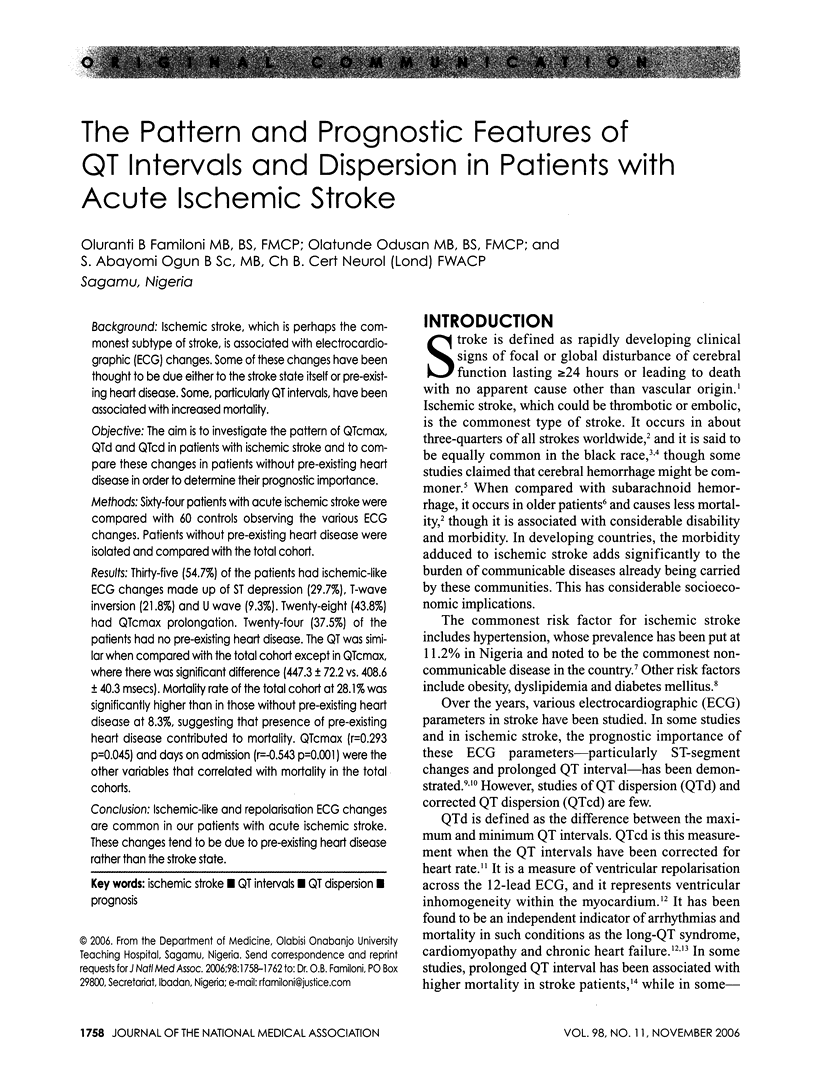
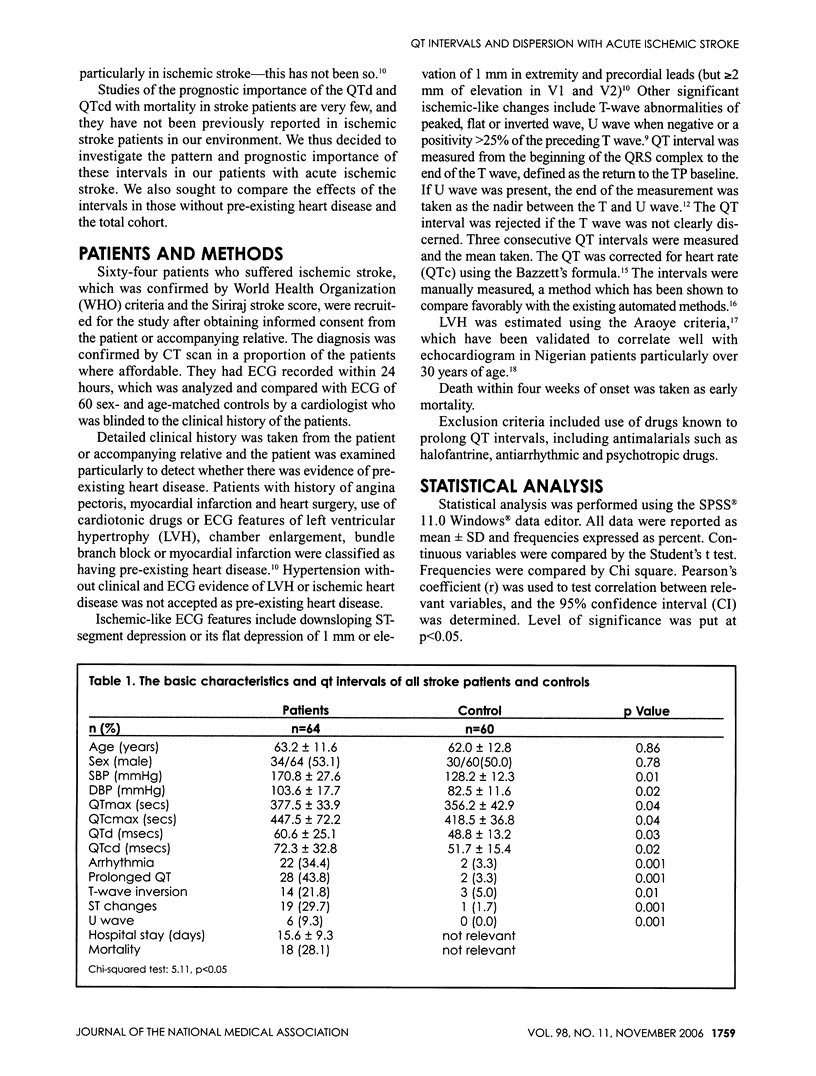
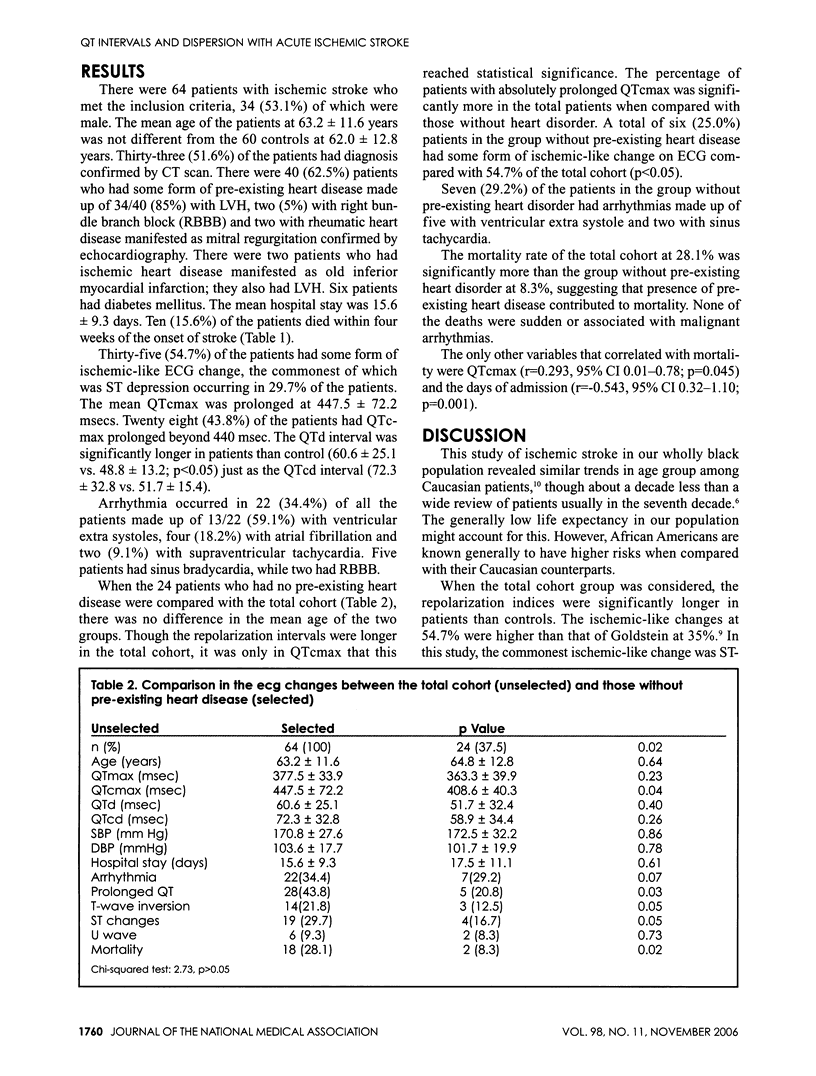
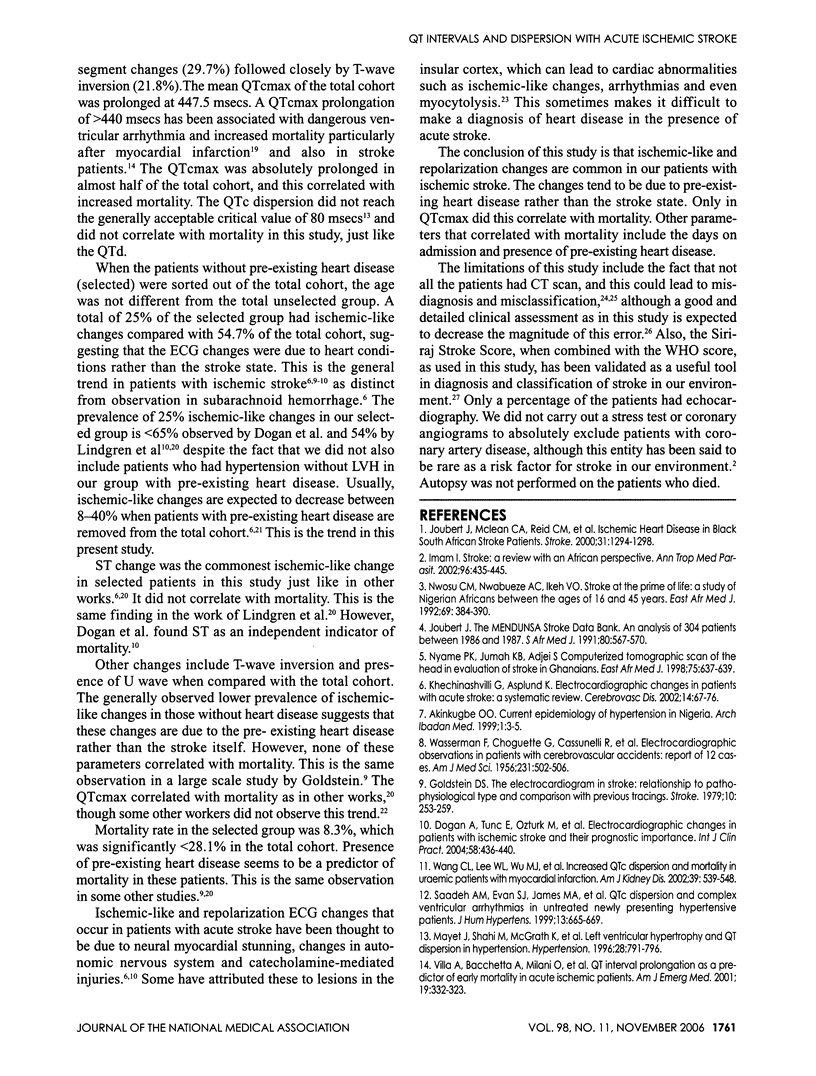
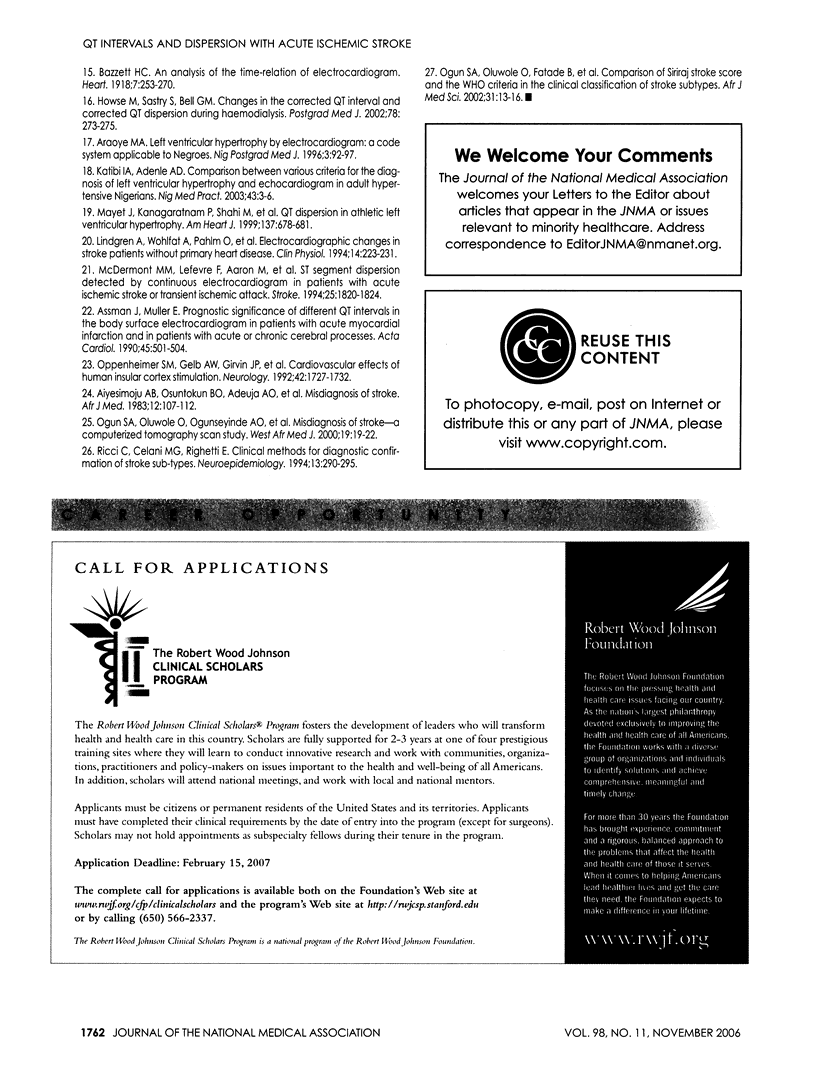
Selected References
These references are in PubMed. This may not be the complete list of references from this article.
- Aiyesimoju A. B., Osuntokun B. O., Adeuja A. O., Olumide A., Ogunseyinde A. O. Misdiagnosis of stroke. Afr J Med Med Sci. 1983 Jun;12(2):107–112. [PubMed] [Google Scholar]
- Assmann I., Müller E. Prognostic significance of different QT-intervals in the body surface ECG in patients with acute myocardial infarction and in patients with acute or chronic cerebral processes. Acta Cardiol. 1990;45(6):501–504. [PubMed] [Google Scholar]
- Dogan A., Tunc E., Ozturk M., Kerman M., Akhan G. Electrocardiographic changes in patients with ischaemic stroke and their prognostic importance. Int J Clin Pract. 2004 May;58(5):436–440. doi: 10.1111/j.1368-5031.2004.00010.x. [DOI] [PubMed] [Google Scholar]
- Goldstein D. S. The electrocardiogram in stroke: relationship to pathophysiological type and comparison with prior tracings. Stroke. 1979 May-Jun;10(3):253–259. doi: 10.1161/01.str.10.3.253. [DOI] [PubMed] [Google Scholar]
- Howse M., Sastry S., Bell G. M. Changes in the corrected QT interval and corrected QT dispersion during haemodialysis. Postgrad Med J. 2002 May;78(919):273–275. doi: 10.1136/pmj.78.919.273. [DOI] [PMC free article] [PubMed] [Google Scholar]
- Imam I. Stroke: a review with an African perspective. Ann Trop Med Parasitol. 2002 Jul;96(5):435–445. doi: 10.1179/000349802125001276. [DOI] [PubMed] [Google Scholar]
- Joubert J., McLean C. A., Reid C. M., Davel D., Pilloy W., Delport R., Steyn L., Walker A. R. Ischemic heart disease in black South African stroke patients. Stroke. 2000 Jun;31(6):1294–1298. doi: 10.1161/01.str.31.6.1294. [DOI] [PubMed] [Google Scholar]
- Joubert J. The MEDUNSA Stroke Data Bank. An analysis of 304 patients seen between 1986 and 1987. S Afr Med J. 1991 Dec 7;80(11-12):567–570. [PubMed] [Google Scholar]
- Khechinashvili George, Asplund Kjell. Electrocardiographic changes in patients with acute stroke: a systematic review. Cerebrovasc Dis. 2002;14(2):67–76. doi: 10.1159/000064733. [DOI] [PubMed] [Google Scholar]
- Lindgren A., Wohlfart B., Pahlm O., Johansson B. B. Electrocardiographic changes in stroke patients without primary heart disease. Clin Physiol. 1994 Mar;14(2):223–231. doi: 10.1111/j.1475-097x.1994.tb00508.x. [DOI] [PubMed] [Google Scholar]
- Mayet J., Kanagaratnam P., Shahi M., Senior R., Doherty M., Poulter N. R., Sever P. S., Handler C. E., Thom S. A., Foale R. A. QT dispersion in athletic left ventricular hypertrophy. Am Heart J. 1999 Apr;137(4 Pt 1):678–681. doi: 10.1016/s0002-8703(99)70222-x. [DOI] [PubMed] [Google Scholar]
- Mayet J., Shahi M., McGrath K., Poulter N. R., Sever P. S., Foale R. A., Thom S. A. Left ventricular hypertrophy and QT dispersion in hypertension. Hypertension. 1996 Nov;28(5):791–796. doi: 10.1161/01.hyp.28.5.791. [DOI] [PubMed] [Google Scholar]
- McDermott M. M., Lefevre F., Arron M., Martin G. J., Biller J. ST segment depression detected by continuous electrocardiography in patients with acute ischemic stroke or transient ischemic attack. Stroke. 1994 Sep;25(9):1820–1824. doi: 10.1161/01.str.25.9.1820. [DOI] [PubMed] [Google Scholar]
- Nwosu C. M., Nwabueze A. C., Ikeh V. O. Stroke at the prime of life: a study of Nigerian Africans between the ages of 16 and 45 years. East Afr Med J. 1992 Jul;69(7):384–390. [PubMed] [Google Scholar]
- Nyame P. K., Jumah K. B., Adjei S. Computerised tomographic scan of the head in evaluation of stroke in Ghanaians. East Afr Med J. 1998 Nov;75(11):637–639. [PubMed] [Google Scholar]
- Ogun S. A., Oluwole O., Fatade B., Ogunseyinde A. O., Ojini F. I., Odusote K. A. Comparison of Siriraj Stroke Score and the WHO criteria in the clinical classification of stroke subtypes. Afr J Med Med Sci. 2002 Mar;31(1):13–16. [PubMed] [Google Scholar]
- Ogun S. A., Oluwole O., Ogunseyinde A. O., Fatade B., Odusote K. A. Misdiagnosis of stroke--a computerised tomography scan study. West Afr J Med. 2000 Jan-Mar;19(1):19–22. [PubMed] [Google Scholar]
- Oppenheimer S. M., Gelb A., Girvin J. P., Hachinski V. C. Cardiovascular effects of human insular cortex stimulation. Neurology. 1992 Sep;42(9):1727–1732. doi: 10.1212/wnl.42.9.1727. [DOI] [PubMed] [Google Scholar]
- Ricci S., Celani M. G., Righetti E. Clinical methods for diagnostic confirmation of stroke subtypes. Neuroepidemiology. 1994;13(6):290–295. doi: 10.1159/000110393. [DOI] [PubMed] [Google Scholar]
- Saadeh A., Evans S., James M., Jones J. QTc dispersion and complex ventricular arrhythmias in untreated newly presenting hypertensive patients. J Hum Hypertens. 1999 Oct;13(10):665–669. doi: 10.1038/sj.jhh.1000908. [DOI] [PubMed] [Google Scholar]
- Villa A., Bacchetta A., Milani O., Omboni E. QT interval prolongation as predictor of early mortality in acute ischemic stroke patients. Am J Emerg Med. 2001 Jul;19(4):332–333. doi: 10.1053/ajem.2001.24450. [DOI] [PubMed] [Google Scholar]
- WASSERMAN F., CHOQUETTE G., CASSINELLI R., BELLET S. Electrocardiographic observations in patients with cerebrovascular accidents; report of 12 cases. Am J Med Sci. 1956 May;231(5):502–510. doi: 10.1097/00000441-195605000-00003. [DOI] [PubMed] [Google Scholar]
- Wang Chia-Liang, Lee Wen-Lieng, Wu Ming-Ju, Cheng Chi-Hung, Chen Cheng-Hsu, Shu Kuo-Hsiung. Increased QTc dispersion and mortality in uremic patients with acute myocardial infarction. Am J Kidney Dis. 2002 Mar;39(3):539–548. doi: 10.1053/ajkd.2002.31418. [DOI] [PubMed] [Google Scholar]


